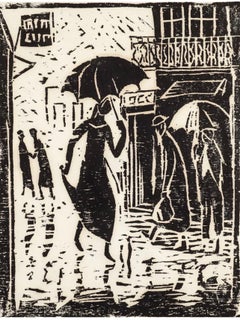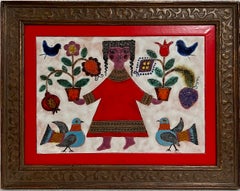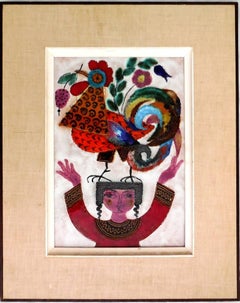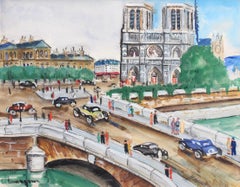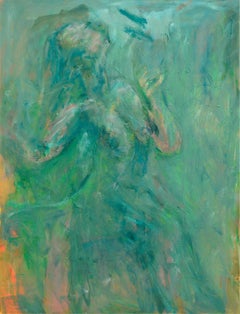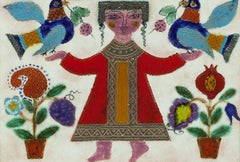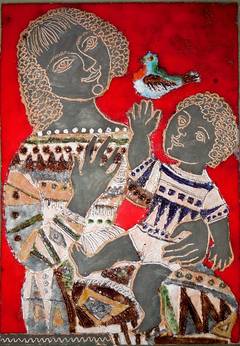Irene Awret Art
to
3
Overall Width
to
Overall Height
to
3
3
3
2
1
2
2
2
1
1
1
1
2
2
2
1
4
7,820
5,167
2,504
1,501
3
Artist: Irene Awret
Woodblock Print Polish Israeli Artist Azriel Awret Rainy Street Jerusalem Israel
By Irene Awret
Located in Surfside, FL
Awret, Azriel (Polish Israeli, 1910-2010),
Rainy Street in Jerusalem,
Woodblock print, 9.75 x 7.5 inches, pencil hand signed and numbered 35/60, framed measuring 19.5 x 14.25 inches.
Azriel Awret was born in Lodz, Poland, and moved to Belgium where he lived in Brussels. He married an Aryan woman, Anna Louisa Bonhiere, which saved him from deportation. But in January 1943 he was interned in Malines camp. Awret was an engineer, so he was given employment as an electrician. While in Malines he met Irène Spicker, who was working in the Mahlerstube (art workshop). They married after the war and moved to Israel, settling in Safed and continuing their artistic activity. Today they divide their time between Israel and the United States.
The Beit Lohamei Haghetaot (The Ghetto Fighters’ House Museum) art collection includes works by Awret from his time in Malines. These works depict various aspects of life in Malines, including figures of internees. They were donated by the artist.
He collaborated with his wife in a naif, folk art style.
Irène Awret...
Category
1950s Expressionist Irene Awret Art
Materials
Woodcut
Girl & Plants Enamel Glazed Ceramic Plaque Israeli Artist Awret Naive Folk Art
By Irene Awret
Located in Surfside, FL
This is a rare ceramic plaque painted with enamel glaze by famed Israeli German artist Irene Awret (these are generally hand signed Awret Safed on the verso. I just have not opened the frame to check) the actual glazed ceramic is 10.25 X 14.75 inches.
It depicts a girl or woman with potted plants, birds, pomegranates and other fruits and flowers in a naif, folk art style.
Irène Awret was born to a Jewish family in Berlin called Spicker, the youngest of three children. Her mother died in 1927, when Irène was six years old. In 1937 she was forced to stop high school, due to the Nazi race laws. Because she could not continue her regular studies, her father sent her to study drawing, painting and art restoration with a Jewish painter. Among his students were a large number of German Jews who knew they would have to leave Germany within a short time and would require a profession to enable them to support themselves.
When the situation grew worse, following the Kristallnacht (the first major attack on German and Austrian Jews in November 1938), her uncle decided to move to Belgium. In 1939 the situation became even worse - her father was fired from his job and the family were forced to leave their home. As a result, Awret's father tried to send her and her sister to Belgium, with the help of smugglers. The first smuggler proved to be a double agent and they were sent back from Aachen to Berlin. Two weeks later they made a second, successful, attempt to sneak across the border.
Awret worked for a Dutch Jewish family as a maid. As she had her room and board there, she was able to save enough money to study art part-time at Brussels' Académie Royal des Beaux-Arts. A few months later Awret's father joined her and her financial situation became easier. She left her job and studied full-time, helping support herself with restoration work when it was available and by painting portraits to order.
Later, Awret found a hiding place on a farm in Waterloo with a Jewish family who were connected with the underground. In January 1943 she had to return to Brussels, living with a false identity card which stated she was a married woman with two children. Awret succeeded in renting an attic without informing the police where she was - she told her landlady that she had been forced to flee her husband because he beat her. While there, she supported herself by restoring wooden sculptures.
A Jewish informer gave her up to the Gestapo, accompanying the two Gestapo men who arrested her. Awret was able to take a bag containing food and drawing materials. She was detained in the Gestapo cellars in Brussels where she drew. Because there was nothing there to draw, she sketched her own hand (view this work). Awret was interrogated in order to reveal the hiding place of her father who was still in Brussels. The National Socialist regime was determined to persecute him, even though he had fought for Germany in World War I and been permanently disabled. They stepped up their torture and brought Awret before Hartmann, the head of the Gestapo in Brussels. When Hartmann saw her block of drawings, he asked her where she had studied art and halted the interrogation.
Awret was placed in a narrow cell and then transferred to Malines camp, which the Belgian's called Mechelen. Malines was a transit camp to Auschwitz, regularly sending 2000 people at a time. Although she arrived just before Transport No. 20, Irène Awret avoided being included. Instead she was put to work in the leather workshop, decorating broaches. While she was there, Hartmann visited the camp and spotted her: "I could have discovered where your father is hiding," he told her. When her artistic talents became known, she was transferred to the Mahlerstube (artist's workshop) where she worked producing graphics for the Germans until the end of the war. When Carol (Karel) Deutsch (whose works are now on view at Yad Vashem) was sent from Mechelen to his death with his wife, he left young Irene his paintbox. Irene also recalls seeing the great painter Felix Nussbaum and his wife being pushed into a boxcar bound for the gas, and tells of the aftermath of the famous 20th Train incident, when a young Jewish doctor armed only with a pistol and helped by two unarmed friends with a lantern ambushed one of Mechelen's Auschwitz-bound trains carrying 1,618 Jews, most of whom had fled Eastern Europe for Belgium.
Awret's job enabled her to paint and draw - mainly in pencil, but also in watercolors and oils. In the artists' workshop she met a Jewish refugee from Poland - Azriel Awret - who would later become her husband. Among the other artists in the workshop were Herbert von Ledermann-Vütemberg, a sculptor from an aristocratic family with Jewish roots, Léon Landau, and Smilowitz, who perished in the camps in the East. Irène and Azriel tried to bribe a German officer to prevent Smilowitz's deportation. Not only were they unsuccessful, but they were almost put onto the same train. Jacques Ochs was another artist with whom they became friends in the camp. Ochs, a French-born Protestant who lived in Belgium, was interned as a political prisoner. He remained in Belgium after liberation.
After the war the Awrets immigrated to Israel and made their home in Safed. They continued to work, and were instrumental in founding Safed's artists' quarter.
The Beit Lohamei Haghetaot (Ghetto Fighters' House Museum) art collection holds works donated by Awret. These date from her time in Malines camp and from her stay in Brussels after the war, when she was in the company of orphans who had hidden while their parents were sent to Auschwitz. Her highly expressive works have made their way to exhibitions at theTel Aviv Museum, the Haifa Museum of Modern Art and the Modern Art Gallery in Washington, D.C., as well as into the private collections of such individuals as Dr. Jonas Salk...
Category
1950s Expressionist Irene Awret Art
Materials
Enamel
Girl & Rooster Enamel Glazed Ceramic Plaque Israeli Artist Awret Naive Folk Art
By Irene Awret
Located in Surfside, FL
This is a rare ceramic plaque painted with enamel glaze by famed Israeli German artist Irene Awret is signed Awret Safed on the verso. the actual glazed ceramic is 10X15 inches.
Irène Awret was born to a Jewish family in Berlin called Spicker, the youngest of three children. Her mother died in 1927, when Irène was six years old. In 1937 she was forced to stop high school, due to the Nazi race laws. Because she could not continue her regular studies, her father sent her to study drawing, painting and art restoration with a Jewish painter. Among his students were a large number of German Jews who knew they would have to leave Germany within a short time and would require a profession to enable them to support themselves.
When the situation grew worse, following the Kristallnacht (the first major attack on German and Austrian Jews in November 1938), her uncle decided to move to Belgium. In 1939 the situation became even worse - her father was fired from his job and the family were forced to leave their home. As a result, Awret's father tried to send her and her sister to Belgium, with the help of smugglers. The first smuggler proved to be a double agent and they were sent back from Aachen to Berlin. Two weeks later they made a second, successful, attempt to sneak across the border.
Awret worked for a Dutch Jewish family as a maid. As she had her room and board there, she was able to save enough money to study art part-time at Brussels' Académie Royal des Beaux-Arts. A few months later Awret's father joined her and her financial situation became easier. She left her job and studied full-time, helping support herself with restoration work when it was available and by painting portraits to order.
Later, Awret found a hiding place on a farm in Waterloo with a Jewish family who were connected with the underground. In January 1943 she had to return to Brussels, living with a false identity card which stated she was a married woman with two children. Awret succeeded in renting an attic without informing the police where she was - she told her landlady that she had been forced to flee her husband because he beat her. While there, she supported herself by restoring wooden sculptures.
A Jewish informer gave her up to the Gestapo, accompanying the two Gestapo men who arrested her. Awret was able to take a bag containing food and drawing materials. She was detained in the Gestapo cellars in Brussels where she drew. Because there was nothing there to draw, she sketched her own hand (view this work). Awret was interrogated in order to reveal the hiding place of her father who was still in Brussels. The National Socialist regime was determined to persecute him, even though he had fought for Germany in World War I and been permanently disabled. They stepped up their torture and brought Awret before Hartmann, the head of the Gestapo in Brussels. When Hartmann saw her block of drawings, he asked her where she had studied art and halted the interrogation.
Awret was placed in a narrow cell and then transferred to Malines camp, which the Belgian's called Mechelen. Malines was a transit camp to Auschwitz, regularly sending 2000 people at a time. Although she arrived just before Transport No. 20, Irène Awret avoided being included. Instead she was put to work in the leather workshop, decorating broaches. While she was there, Hartmann visited the camp and spotted her: "I could have discovered where your father is hiding," he told her. When her artistic talents became known, she was transferred to the Mahlerstube (artist's workshop) where she worked producing graphics for the Germans until the end of the war. When Carol (Karel) Deutsch (whose works are now on view at Yad Vashem) was sent from Mechelen to his death with his wife, he left young Irene his paintbox. Irene also recalls seeing the great painter Felix Nussbaum and his wife being pushed into a boxcar bound for the gas, and tells of the aftermath of the famous 20th Train incident, when a young Jewish doctor armed only with a pistol and helped by two unarmed friends with a lantern ambushed one of Mechelen's Auschwitz-bound trains carrying 1,618 Jews, most of whom had fled Eastern Europe for Belgium.
Awret's job enabled her to paint and draw - mainly in pencil, but also in watercolors and oils. In the artists' workshop she met a Jewish refugee from Poland - Azriel Awret...
Category
1950s Expressionist Irene Awret Art
Materials
Enamel
Related Items
Notre Dame de Paris
By Lucien Génin
Located in London, GB
'Notre Dame de Paris', gouache on paper, by Lucien Génin (circa 1930s). An absolutely charming and now, historic depiction from the 1930s, of the most famous cathedral in France. It is one of the most widely recognised symbols of the city of Paris and the French nation. As the cathedral of the Archdiocese of Paris, Notre-Dame contains the cathedra of the Archbishop of Paris. Approximately 12 million people visit Notre-Dame annually, making it the most visited monument in Paris. While undergoing renovation and restoration, the roof of Notre-Dame caught fire on the evening of 15 April 2019. Burning for around 15 hours, the cathedral sustained serious damage. The government of France hopes the reconstruction can be completed by Spring 2024, in time for the opening of the 2024 Summer Olympics in Paris. Unlike the actual cathedral, this artwork is in good condition, is newly framed and glazed and signed by the artist in the lower left hand corner. Upon request a video may be provided.
About the Artist: After the devastation of the First World War, Lucien Génin (1894 - 1953) left his provincial home in the autumn of 1919 to find his fortune among the lively Parisians in the heart of Montmartre. Génin befriended the painters Frank Will, Gen Paul, Émile Boyer, Marcel Leprin...
Category
1930s Expressionist Irene Awret Art
Materials
Paper, Gouache
Teal Figurative Abstract
By Daniel David Fuentes
Located in Soquel, CA
Dynamic teal figurative abstract by San Jose, California area artist Daniel David Fuentes (American, 1978-2016). From a collection of his works. Signed "Daniel Fuentes" on verso. Unf...
Category
21st Century and Contemporary Expressionist Irene Awret Art
Materials
Canvas, Oil
The Port of Le Havre
By Fred Pailhès
Located in London, GB
'The Port of Le Havre', pencil on art paper, by French artist Fred Pailhès (circa 1950s). Le Havre was only a fishing village until 1517, when Francis I h...
Category
1950s Expressionist Irene Awret Art
Materials
Paper, Pencil
Expressionist Gouache and Watercolour Study for 'Alexander and His Army'.
Located in Cotignac, FR
French late 20th century watercolour and gouache study for the series 'Alexander and His Army' by Stephane Lovighi-Bourgogne. Presented in plain wood frame.
A strong and forceful de...
Category
Late 20th Century Expressionist Irene Awret Art
Materials
Paper, Watercolor, Gouache
H 21.5 in W 27.5 in D 0.5 in
Le Pont Neuf
By Lucien Génin
Located in London, GB
'Le Pont Neuf', gouache on fine art paper, by Lucien Génin (circa 1930s). The Pont Neuf is the oldest standing bridge across the river Seine in Paris, France. It stands by the western point of the Île de la Cité, the island in the middle of the river that was, between 250 and 225 BC, the birthplace of Paris. It is called 'The New Bridge' because at the time of its inauguration (built 1578-1607), it embodied a very modern look compared to other bridges which spanned the Seine. Lucien Génin has captured its beauty in this lively depiction from the 1930s. Just before the bridge is a 'Bateau Mouche' an open excursion boat that provides visitors with a view of the city from along the river. The artwork is in good overall condition commensurate with age and medium used. It has been newly frame with anti-reflective glass. Please enjoy the photos accompanying this listing. Signed by the artist in the lower left hand. Upon request a video may be provided.
About the Artist: After the devastation of the First World War, Lucien Génin (1894 - 1953) left his provincial home in the autumn of 1919 to find his fortune among the lively Parisians in the heart of Montmartre. Génin befriended the painters Frank Will, Gen Paul, Émile Boyer, Marcel Leprin...
Category
1930s Expressionist Irene Awret Art
Materials
Paper, Gouache
"Seated Young Man" by Wilson - Young Man over Dark Background - Intimate Nude
By Shana Wilson
Located in Carmel, CA
Shana Wilson (Canadian, born 1966)
"Seated Young Man" 2014
Oil Paint, Wood Panel, Wire
The artist signed the back of the painting.
Shana Wilson, born in Edmonton in 1966, has carved...
Category
2010s Expressionist Irene Awret Art
Materials
Wire
H 48 in W 48 in D 1.5 in
Watercolor Portrait of a Soldier in a Large Black Frame
Located in Pasadena, CA
In this watercolor portrait, framed in a large black frame, the viewer is captivated by the three-quarter head depiction of a middle-aged soldier. Th...
Category
Mid-20th Century Expressionist Irene Awret Art
Materials
Oil
Nude by the Window, San Francisco Bay Area Figurative Movement 1966
By Thomas L. Tribby
Located in Soquel, CA
Bay Area figurative painting of a nude woman looking over her shoulder by Thomas L. Tribby (American, b. 1944). Signed and dated "Tribby 66" in the lower right corner. Unframed, but the edges are painted black for a frame-less display. Canvas size: 37.5"H x 33.5"W. Bay area figurative artist and painted while at the University of California, Berkeley, CA – Bachelor of Arts, 1963-1966. Flat rate Shipping $100 quoted.
Thomas Tribby (American, b. 1944) is an internationally known artist who has participated in solo and group exhibitions in the United States and Europe.
He works in a variety of media, including watercolor, acrylic, and oil. Tribby has gallery representation in Florida and his paintings have been featured in articles in Waterfront Home and Design and Architectural Digest. Tribby has participated in juried and invitational shows in Florida, California, Arizona, Georgia, South Carolina, Tennessee, Washington, D.C., and New York, and in Paris, France.
In December 2007, Tribby had the honor of being one of nine painters in the American Delegation at Le Salon des Beaux Arts de la Société Nationale des Beaux Arts exhibition, known as the Paris Salon, at the Carrousel du Louvre in Paris, where his painting, Lifeguard, was exhibited.
In January 2008 Tribby received from the Design Center of the Americas, DCOTA, the prestigious Stars of Design award in the category of Art.
Tribby lives and works in West Palm Beach, Florida.
EDUCATION
1961-1963 University of Washington, Seattle, WA Studies in Fine Arts
1963-1966 University of California, Berkeley, CA – Bachelor of Arts
1969-1970 Arizona State University, Tempe, AZ, Grad Studies, MFA Program
1979-1980 Arizona State University, Tempe, AZ, Grad Studies, MFA Program
GROUP EXHIBITIONS: INVITATIONAL OR JURIED
2014 Monochrome, Palm Beach Cultural Council, Lake Worth, FL
2010 Spectrum 2010, The Hunter Museum of American Art, Chattanooga, TN
2010 Studio 1608 Group Show, West Palm Beach, FL
2008 Florida Original Contemporary Art, West Palm Beach, FL
2007 Paris Salon, Carrousel du Louvre, Paris, France
2005 Liman Gallery, Palm Beach, FL
2003 Grand Bank and Trust, Palm Beach Gardens, FL
2003 Aaron Gallery, Washington D.C.
2001 The Retreat, Artists Against Abuse, Southampton, NY
2000, 2003-2004 Palm Street Art Studios, West Palm Beach, FL
1996 Studio 412, Group Show, West Palm Beach, FL
1992, 1994 Small Works Show, Armory Arts Center, WPB, FL
ONE MAN EXHIBITIONS
2018 Armand Bolling Fine Arts, Jupiter, FL
2012, 2016 Ellis-Nicholson Gallery...
Category
1960s Expressionist Irene Awret Art
Materials
Canvas, Oil, Stretcher Bars
H 37.5 in W 33.5 in D 2 in
George Grosz NYC City Scene Modernism Watercolor German Expressionism Weimar
By George Grosz
Located in New York, NY
George Grosz NYC City Scene Modernism Watercolor German Expressionism Weimar
George Grosz (Germany, 1893-1959) "City Scene," 17 x 12 inches, signed and dated “33” lower left, watercolor on paper. This drawing, created while Grosz was living in NYC. Period frame, It has been authenticated by Ralph Jentsch, the globally recognized Grosz expert.
Provenance: Hirschl & Adler and 511 Gallery...
Category
1930s Expressionist Irene Awret Art
Materials
Paper, Watercolor
David Smith Sulzer Engineering Works I Switzerland Watercolor Modern British Art
By David Smith
Located in London, GB
To see our other Modern British Art, scroll down to "More from this Seller" and below it click on "See all from this Seller" - or send us a message if you cannot find the artist you ...
Category
Mid-20th Century Expressionist Irene Awret Art
Materials
Watercolor
Lost Hedgerows Framed Environmental Activism Pastel Artwork Late 20th Century
By Julian Ruddock
Located in Sutton Poyntz, Dorset
Julian Ruddock.
British ( b.1965 ).
Lost Hedgerows.
Pastel On Paper.
Signed Lower Right.
Image size 21.9 inches x 25 inches ( 55.5cm x 63.5cm ).
Frame size 29 inches x 32.1 inches ...
Category
Late 20th Century Expressionist Irene Awret Art
Materials
Paper, Pastel
1970s Expressionist Acrylic. 'Seated Figure'.
Located in Cotignac, FR
An expressionist portrait of a seated figure, acrylic on paper by French artist Alain Caucat. Signed bottom right. Also signed and dated to the back of the framing board. Presented u...
Category
1970s Expressionist Irene Awret Art
Materials
Paper, Acrylic
Previously Available Items
Glazed Israeli Folk Art Naive Tile Figure with Flowers and Birds
By Irene Awret
Located in Surfside, FL
Genre: Modern
Subject: Figures
Medium: Tile, Glaze
Dimensions: 10 1/4 x 14 3/4
Dimensions w/Frame: 16 3/4 x 21 1/2
This is a rare glazed fired ceramic plaque painted with enamel glaze by famed Israeli German artist Irene Awret.
Irène Awret was born to a Jewish family in Berlin called Spicker, the youngest of three children. Her mother died in 1927, when Irène was six years old. In 1937 she was forced to stop high school, due to the Nazi race laws. Because she could not continue her regular studies, her father sent her to study drawing, painting and art restoration with a Jewish painter. Among his students were a large number of German Jews who knew they would have to leave Germany within a short time and would require a profession to enable them to support themselves.
When the situation grew worse, following the Kristallnacht (the first major attack on German and Austrian Jews in November 1938), her uncle decided to move to Belgium. In 1939 the situation became even worse - her father was fired from his job and the family were forced to leave their home. As a result, Awret's father tried to send her and her sister to Belgium, with the help of smugglers. The first smuggler proved to be a double agent and they were sent back from Aachen to Berlin. Two weeks later they made a second, successful, attempt to sneak across the border.
Awret worked for a Dutch Jewish family as a maid. As she had her room and board there, she was able to save enough money to study art part-time at Brussels' Académie Royal des Beaux-Arts. A few months later Awret's father joined her and her financial situation became easier. She left her job and studied full-time, helping support herself with restoration work when it was available and by painting portraits to order.
Later, Awret found a hiding place on a farm in Waterloo with a Jewish family who were connected with the underground. In January 1943 she had to return to Brussels, living with a false identity card which stated she was a married woman with two children. Awret succeeded in renting an attic without informing the police where she was - she told her landlady that she had been forced to flee her husband because he beat her. While there, she supported herself by restoring wooden sculptures.
A Jewish informer gave her up to the Gestapo, accompanying the two Gestapo men who arrested her. Awret was able to take a bag containing food and drawing materials. She was detained in the Gestapo cellars in Brussels where she drew. Because there was nothing there to draw, she sketched her own hand (view this work). Awret was interrogated in order to reveal the hiding place of her father who was still in Brussels. The National Socialist regime was determined to persecute him, even though he had fought for Germany in World War I and been permanently disabled. They stepped up their torture and brought Awret before Hartmann, the head of the Gestapo in Brussels. When Hartmann saw her block of drawings, he asked her where she had studied art and halted the interrogation.
Awret was placed in a narrow cell and then transferred to Malines camp, which the Belgian's called Mechelen. Malines was a transit camp to Auschwitz, regularly sending 2000 people at a time. Although she arrived just before Transport No. 20, Irène Awret avoided being included. Instead she was put to work in the leather workshop, decorating broaches. While she was there, Hartmann visited the camp and spotted her: "I could have discovered where your father is hiding," he told her. When her artistic talents became known, she was transferred to the Mahlerstube (artist's workshop) where she worked producing graphics for the Germans until the end of the war. When Carol (Karel) Deutsch (whose works are now on view at Yad Vashem) was sent from Mechelen to his death with his wife, he left young Irene his paintbox. Irene also recalls seeing the great painter Felix Nussbaum and his wife being pushed into a boxcar bound for the gas, and tells of the aftermath of the famous 20th Train incident, when a young Jewish doctor armed only with a pistol and helped by two unarmed friends with a lantern ambushed one of Mechelen's Auschwitz-bound trains carrying 1,618 Jews, most of whom had fled Eastern Europe for Belgium.
Awret's job enabled her to paint and draw - mainly in pencil, but also in watercolors and oils. In the artists' workshop she met a Jewish refugee from Poland - Azriel...
Category
20th Century Folk Art Irene Awret Art
Materials
Enamel
Enamel Glazed Ceramic Plaque Mother and Child
By Irene Awret
Located in Surfside, FL
This is a rare ceramic plaque painted with enamel glaze by famed Israeli German artist Irene Awret is signed Awret Safed on the verso. the actual glazed ceramic is 9.5X13.5 inches.
Irène Awret was born to a Jewish family in Berlin called Spicker, the youngest of three children. Her mother died in 1927, when Irène was six years old. In 1937 she was forced to stop high school, due to the Nazi race laws. Because she could not continue her regular studies, her father sent her to study drawing, painting and art restoration with a Jewish painter. Among his students were a large number of German Jews who knew they would have to leave Germany within a short time and would require a profession to enable them to support themselves.
When the situation grew worse, following the Kristallnacht (the first major attack on German and Austrian Jews in November 1938), her uncle decided to move to Belgium. In 1939 the situation became even worse - her father was fired from his job and the family were forced to leave their home. As a result, Awret's father tried to send her and her sister to Belgium, with the help of smugglers. The first smuggler proved to be a double agent and they were sent back from Aachen to Berlin. Two weeks later they made a second, successful, attempt to sneak across the border.
Awret worked for a Dutch Jewish family as a maid. As she had her room and board there, she was able to save enough money to study art part-time at Brussels' Académie Royal des Beaux-Arts. A few months later Awret's father joined her and her financial situation became easier. She left her job and studied full-time, helping support herself with restoration work when it was available and by painting portraits to order.
Later, Awret found a hiding place on a farm in Waterloo with a Jewish family who were connected with the underground. In January 1943 she had to return to Brussels, living with a false identity card which stated she was a married woman with two children. Awret succeeded in renting an attic without informing the police where she was - she told her landlady that she had been forced to flee her husband because he beat her. While there, she supported herself by restoring wooden sculptures.
A Jewish informer gave her up to the Gestapo, accompanying the two Gestapo men who arrested her. Awret was able to take a bag containing food and drawing materials. She was detained in the Gestapo cellars in Brussels where she drew. Because there was nothing there to draw, she sketched her own hand (view this work). Awret was interrogated in order to reveal the hiding place of her father who was still in Brussels. The National Socialist regime was determined to persecute him, even though he had fought for Germany in World War I and been permanently disabled. They stepped up their torture and brought Awret before Hartmann, the head of the Gestapo in Brussels. When Hartmann saw her block of drawings, he asked her where she had studied art and halted the interrogation.
Awret was placed in a narrow cell and then transferred to Malines camp, which the Belgian's called Mechelen. Malines was a transit camp to Auschwitz, regularly sending 2000 people at a time. Although she arrived just before Transport No. 20, Irène Awret avoided being included. Instead she was put to work in the leather workshop, decorating broaches. While she was there, Hartmann visited the camp and spotted her: "I could have discovered where your father is hiding," he told her. When her artistic talents became known, she was transferred to the Mahlerstube (artist's workshop) where she worked producing graphics for the Germans until the end of the war. When Carol (Karel) Deutsch (whose works are now on view at Yad Vashem) was sent from Mechelen to his death with his wife, he left young Irene his paintbox. Irene also recalls seeing the great painter Felix Nussbaum and his wife being pushed into a boxcar bound for the gas, and tells of the aftermath of the famous 20th Train incident, when a young Jewish doctor armed only with a pistol and helped by two unarmed friends with a lantern ambushed one of Mechelen's Auschwitz-bound trains carrying 1,618 Jews, most of whom had fled Eastern Europe for Belgium.
Awret's job enabled her to paint and draw - mainly in pencil, but also in watercolors and oils. In the artists' workshop she met a Jewish refugee from Poland - Azriel Awret...
Category
20th Century Folk Art Irene Awret Art
Materials
Ceramic
Girl with Rooster, Enamel Glazed Ceramic Plaque
By Irene Awret
Located in Surfside, FL
This is a rare ceramic plaque painted with enamel glaze by famed Israeli German artist Irene Awret is signed Awret Safed on the verso. the actual glazed ceramic is 10X15 inches.
Irène Awret was born to a Jewish family in Berlin called Spicker, the youngest of three children. Her mother died in 1927, when Irène was six years old. In 1937 she was forced to stop high school, due to the Nazi race laws. Because she could not continue her regular studies, her father sent her to study drawing, painting and art restoration with a Jewish painter. Among his students were a large number of German Jews who knew they would have to leave Germany within a short time and would require a profession to enable them to support themselves.
When the situation grew worse, following the Kristallnacht (the first major attack on German and Austrian Jews in November 1938), her uncle decided to move to Belgium. In 1939 the situation became even worse - her father was fired from his job and the family were forced to leave their home. As a result, Awret's father tried to send her and her sister to Belgium, with the help of smugglers. The first smuggler proved to be a double agent and they were sent back from Aachen to Berlin. Two weeks later they made a second, successful, attempt to sneak across the border.
Awret worked for a Dutch Jewish family as a maid. As she had her room and board there, she was able to save enough money to study art part-time at Brussels' Académie Royal des Beaux-Arts. A few months later Awret's father joined her and her financial situation became easier. She left her job and studied full-time, helping support herself with restoration work when it was available and by painting portraits to order.
Later, Awret found a hiding place on a farm in Waterloo with a Jewish family who were connected with the underground. In January 1943 she had to return to Brussels, living with a false identity card which stated she was a married woman with two children. Awret succeeded in renting an attic without informing the police where she was - she told her landlady that she had been forced to flee her husband because he beat her. While there, she supported herself by restoring wooden sculptures.
A Jewish informer gave her up to the Gestapo, accompanying the two Gestapo men who arrested her. Awret was able to take a bag containing food and drawing materials. She was detained in the Gestapo cellars in Brussels where she drew. Because there was nothing there to draw, she sketched her own hand (view this work). Awret was interrogated in order to reveal the hiding place of her father who was still in Brussels. The National Socialist regime was determined to persecute him, even though he had fought for Germany in World War I and been permanently disabled. They stepped up their torture and brought Awret before Hartmann, the head of the Gestapo in Brussels. When Hartmann saw her block of drawings, he asked her where she had studied art and halted the interrogation.
Awret was placed in a narrow cell and then transferred to Malines camp, which the Belgian's called Mechelen. Malines was a transit camp to Auschwitz, regularly sending 2000 people at a time. Although she arrived just before Transport No. 20, Irène Awret avoided being included. Instead she was put to work in the leather workshop, decorating broaches. While she was there, Hartmann visited the camp and spotted her: "I could have discovered where your father is hiding," he told her. When her artistic talents became known, she was transferred to the Mahlerstube (artist's workshop) where she worked producing graphics for the Germans until the end of the war. When Carol (Karel) Deutsch (whose works are now on view at Yad Vashem) was sent from Mechelen to his death with his wife, he left young Irene his paintbox. Irene also recalls seeing the great painter Felix Nussbaum and his wife being pushed into a boxcar bound for the gas, and tells of the aftermath of the famous 20th Train incident, when a young Jewish doctor armed only with a pistol and helped by two unarmed friends with a lantern ambushed one of Mechelen's Auschwitz-bound trains carrying 1,618 Jews, most of whom had fled Eastern Europe for Belgium.
Awret's job enabled her to paint and draw - mainly in pencil, but also in watercolors and oils. In the artists' workshop she met a Jewish refugee from Poland - Azriel Awret...
Category
1950s Expressionist Irene Awret Art
Materials
Enamel
Irene Awret art for sale on 1stDibs.
Find a wide variety of authentic Irene Awret art available for sale on 1stDibs. You can also browse by medium to find art by Irene Awret in ceramic, enamel, metal and more. Much of the original work by this artist or collective was created during the 1950s and is mostly associated with the Expressionist style. Not every interior allows for large Irene Awret art, so small editions measuring 18 inches across are available. Customers who are interested in this artist might also find the work of Erich Waske, Heinrich Richter (b.1884), and Bernard Lorjou. Irene Awret art prices can differ depending upon medium, time period and other attributes. On 1stDibs, the price for these items starts at $1,200 and tops out at $1,200, while the average work can sell for $1,200.
